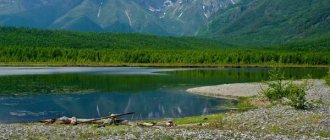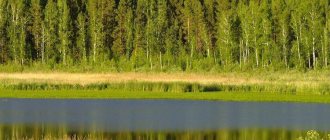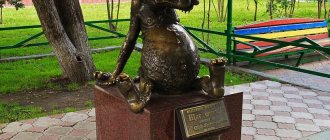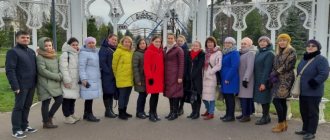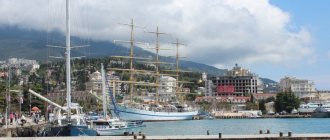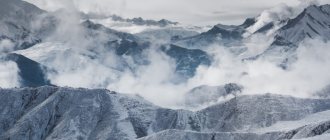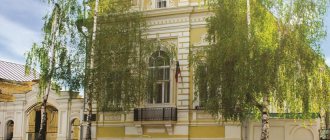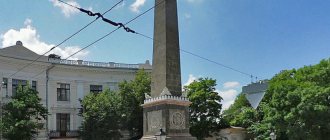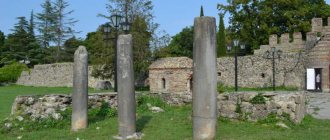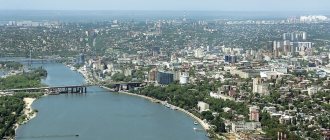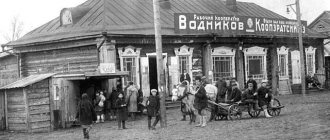Baikal
This lake of tectonic origin is the deepest on the planet (1642 meters), and contains about 19% of the world's fresh water. Due to its impressive size - 620 kilometers in length and up to 79 kilometers in width - it is often called the Siberian Sea.
Baikal is located in a basin and is surrounded on all sides by picturesque mountains. Its symbol is considered to be the Shaman Stone - a rock at the source of the Angara River, which once served as a haven for the rituals of Buryat shamans.
Baikal is attractive at any time of the year - in summer, Chivyrkuisky Bay is popular with its sunny beaches and thermal springs, where there are many comfortable bases for fishing enthusiasts, children's summer camps, walking and helicopter excursion tours; In winter you can ride snowmobiles and dog sleds, sleds and alpine skiing.
Selenga River
Being the largest of the rivers flowing into Baikal, the Selenga provides up to half of the water inflow into the lake. At its confluence, it forms a vast delta with an area of about 540 square kilometers - due to the large amount of suspended solids, this place looks like a huge swampy plain with islands between the water channels. The Selenga Delta is home to hundreds of species of nesting birds and a stopover and resting place for migratory birds.
The river flows through a flat area, along it there are many monasteries and churches, as well as recreation centers and boarding houses inviting lovers of fishing, hunting, and rafting. Excursion tours cover ancient sites and archeological monuments of the Paleolithic and Neolithic eras - rock paintings and burial grounds.
Sarma Gorge
The word “sarma” is translated from Buryat as “bull crossing”; this is the name of a river, a village, a gorge and one of the most terrible winds on Lake Baikal. The Sarma River flowing through the Primorsky Ridge flows into the Small Sea - part of Lake Baikal.
Over the millions of years of its existence, its flow has washed a gorge in the rock, through which, like through a wind tunnel, masses of Arctic air rush into the Baikal basin, gaining strength along the way and reaching a speed of 60 meters per second. This wind in 1901 caused the largest ship disaster on the lake.
In ancient times, the approach to the Sarma Gorge was separated from the shore of Lake Baikal by a stone wall - the mouth of the Sarma was considered a sacred territory. At the very beginning of the gorge, rock paintings have been preserved.
Unusual events in Buryatia: Buddhist New Year
Buddhist New Year is celebrated in Buryatia. Sagaalgan, or Tsagaan sar, is celebrated according to the lunar calendar, and the date changes every time. The constant symbol of the holiday is white, which carries purification, renewal and good hopes for the future.
The amazingly beautiful Sagaalgan celebration ceremony takes place in the Ivolginsky datsan. On the penultimate day of the outgoing year, the monks perform the cleansing ritual of Dugjuub: they build a pyramid in advance, which symbolizes everything bad in the previous year, and burn it to the sound of prayers, making way for the new and better. Solemn services after this last for several weeks.
Date of Sagaalgan in 2021-2025:
- 2021 - February 12;
- 2022 - February 1;
- 2023 - February 20;
- 2024 - February 10;
- 2025 - January 29.
The Old Believers living in the village of Bolshoi Kunaley also add color to the cultural tapestry of Buryatia. The tradition of the Old Believers is recognized as part of the UNESCO World Heritage Site. The villagers are engaged in agriculture, many wear traditional clothes and cook in a Russian oven. Their houses are decorated with carved frames, patterned shutters and painted gates - perhaps that is why in 2022 Bolshoy Kunaley received the status of “The Most Beautiful Village in Russia”.
Sayan Mountains
This name combines two mountain systems: Western Sayan, consisting of ice-free ridges separated by intermountain basins, and Eastern Sayan with typical mid-mountain ridges containing glaciers.
The highest peak of the Western Sayan is Kyzyl-Taiga or “red mountain covered with forest” - a sacred place where Tuvans bury their shamans. Due to the lack of vegetation, the peak of the Eastern Sayans received the name Munku-Sardyk - “eternal char”.
The Sayan Mountains are home to many rivers and fish-rich lakes, picturesque waterfalls and basins with archaeological sites. The accessibility of routes and the beauty of almost untouched wild nature attract numerous tourists to these places.
Peak of Love
It is located at an altitude of 2412 meters above sea level and is one of the peaks of the Tunkinskie Goltsy mountain range. You can get to it from the Arshan resort; the climb takes about 5 hours; even a person without special training, ready for grueling descents and ascents, can handle it. As you move up, more and more breathtaking views of the Eastern Sayan mountain ranges and the Tunka Valley spreading below open up.
It is believed that couples in love who visit the Peak of Love reveal the true nature of their feelings - here you can be confident in the strength of the relationship or, conversely, say goodbye to your illusions, which is why the place is sometimes called the Peak of Love and Death.
Valley of Volcanoes (Khi-Gol Pad)
The mountain valley of the Khi-Gol River is located in the Eastern Sayan, in the Okinsky district of Buryatia. On its territory, which is about 20 kilometers long, there are 9 extinct volcanoes.
Now they are sleeping, but thousands of years ago they erupted red-hot lava, spreading 70 kilometers down into the valley of Khi-Gol and Zhombolok, in some places the lava layer reaches 150 meters. Now the lava fields are uplifted, blackened fossils up to 2 meters high, among which there are sinkholes and lakes.
Against the background of lava fields, the regularly truncated cones of the Kropotkin and Peretolchin volcanoes stand out, and the valley is surrounded on all sides by mountain ranges. The beauty and wonder of this place has made it a popular tourist destination.
Ambassadorial Spaso-Preobrazhensky Monastery
This cultural heritage site was founded more than 300 years ago. Green walls and malachite columns distinguish it from other architectural structures. The walls of the monastery are made of baked bricks. It contains the miraculous icons of St. Nicholas the Pleasant and the Sign of the Blessed Virgin Mary. The monastery functioned until the twenties of the last century, until it was liquidated by the Soviet authorities. Monastic life in the church resumed only in 2000. It was then that the once female monastery became a male monastery.
Valley of Shumak springs
These mineral springs are located at an altitude of 1558 meters above sea level on the Shumak River. The place is very picturesque and inaccessible, hidden deep in the Eastern Sayan mountains, often called Little Tibet.
The springs are small, water-filled depressions in the soil, each with a different taste and temperature. This water is classified into a separate type - Shumak - and is used to treat diseases of the musculoskeletal system, cardiovascular and endocrine systems, digestive organs, gynecological diseases, and metabolic disorders.
Many people note the special energy of the Valley of 100 Springs - not only the body, but also the soul is healed here.
Arch “Royal Gate”
The Royal Gate arch is the main highlight of the capital of Buryatia, a must-see place in many guidebooks of Transbaikalia. The “Royal Gate” arch was created in 1871 according to the design of the talented architect N. Pauw. It is a triumphal arch erected in memory of the visit of Tsarevich Nikolai Alexandrovich to Ulan-Ude. Previously, the arch was decorated with two double-headed eagles, but in 1917 they were knocked down and the arch itself was dismantled a few decades later. But in 2006 it was restored again and is a decoration of the city landscape to this day.
Barguzin Valley
It is one of the most beautiful valleys of Buryatia, located in its northeastern part. It extends 230 kilometers in length and up to 35 in width. Locals call the valley “Sacred Land” and “Land of a Thousand Spirits”; Genghis Khan’s maternal ancestors came from here; according to one legend, the Great Khan himself found rest in these places.
There are a large number of attractions in the valley: the Ininsky rock garden gives originality to the landscape - there are many stone blocks growing out of the ground up to 4 meters in diameter, there are areas with thermal springs, rafting is carried out along the Barguzin River, and the upper reaches of the Ulzykha River attract climbers and lovers of off-piste mountain skiing skiing
The owner of the Barguzin Valley is considered to be the Buhe-Shulun Stone (Bull Stone), which is capable of changing the weather.
The top of Baragkhan-Uul (2514 meters) is sacred to Buddhists and shamanists, who often perform rituals here.
At the foot of the Ikat ridge is the Suva Saxon Castle - picturesque rocks reminiscent of the ruins of an ancient castle.
The place of pilgrimage for believers is the dugan (palace) of the goddess Yanzhima (Saraswati), whose face appeared on a mountain near the village of Yarigto in 2005.
6. Semey villages
Once upon a time, Peter's troops brought the Old Believer people - the Semeyskie - to Transbaikalia. The reason for this decision of the sovereign was the shortage of soldiers on the border with the Chinese Empire. Today the Old Believers are one of the attractions of Buryatia. They attract tourists with their unusual customs, traditions and outlook on life. Semey villages are very easy to recognize by their low huts; it is not at all difficult for a tall person to reach the roof of such a hut; the windows are decorated with picturesque windows and the traditional outfits of the village residents. Unlike residents of the European part of the country, the Semeis remember and preserve many of the traditions of their ancestors. During rituals, Old Believers use the technique of polyphonic singing. The Semey people are one of the few peoples in the world included in the UNESCO protection list. Semey villages are a must-see for anyone interested in Old Believer traditions.
Cascade of waterfalls on the Kyngarga River
In the Tunkinskaya Valley, not far from the resort village of Arshan, there is a marble canyon of the Kyngarga River - for a long distance the river bed runs along pinkish-yellow stones of Archean marble polished by water.
In the upper reaches of the river, whose name is translated from Buryat as “drum,” there is a group of 12 waterfalls.
After walking about one and a half kilometers from the village along a well-trodden path, you can reach the first waterfall, 6 meters high. 300 meters upstream there is a second waterfall, consisting of several steps, the largest of which does not exceed 3 meters.
Sable Lakes
These clean taiga lakes with fresh water are considered one of the most picturesque places in the Khamar-Daban mountain range. They are located 25 kilometers from Lake Baikal on the Selenginka River, 28 kilometers south of the Vydrino railway station.
The Sobolinye lakes – Bolshoi and Malyi – have a common body of water, divided by a channel into 2 parts, so in many sources they appear as one whole.
The height difference when climbing to the lakes is small - about 200 meters. In addition to the breathtaking views and places for swimming, travelers are impressed by the vegetation for which this area is called the “Baikal subtropics” - ferns as tall as a man, vast relict poplars with cedars and rowan trees growing on their branches.
Content
- A LITTLE HISTORY OF Shono and Nohoy. Asukhen and Khusuhen
- Ekhirits and Bulagati. Hori
- Xiongnu (Xiongnu)
- Dzhidinsky district
- Ulan-Ude
Buryaad Ulas is the name of this land in the language of the indigenous peoples.
If you look at the map, you can see that the territory of modern Buryatia is entirely mountainous. The plains account for no more than one quarter of the entire area of the region. It is also rich in water resources. There are about 35 thousand lakes and more than 30 thousand rivers and streams.
Buryatia is beautiful, proud and majestic, rebellious and harsh. Winter here is long and frosty, lasting about six months, and summer is hot. However, strong temperature changes are typical not only in the off-season, but also during the day. “A day in a T-shirt, a day in a sweatshirt” - this saying reflects the essence of the Siberian climate. Yes, this vacation is not for those who are accustomed to southern resorts and like to lazily lie on the beach and splash in the warm water. By the way, there are also places here that we will definitely tell you about. In general, decide which vacation is closest to your heart.
And if you are a real traveler and are not afraid of difficulties - WELCOME TO BURYATIA!
Ushkany Islands
This small rocky archipelago is located in the middle part of Lake Baikal, in the Barguzin region, and represents the peaks of the underwater Academichesky Ridge.
There are four islands in total - Big and Small (Thin, Long, Round). The archipelago is part of the Transbaikal National Park; special permission is required to land on it.
The microclimate of the islands is unique - here you can see Daurian larch, Uskan birch with a black trunk, tree crowns stretching out like fluttering flags, and thickets of Daurian rhododendron blooming purple.
On Bolshoy Ushkan there are a huge number of anthills, as well as caves in which traces of ancient people’s sites were discovered. But the main feature of the archipelago is the Baikal seal or ringed seal - the rocky shores of the islands serve as a rookery for thousands of these animals.
Where can you go from Russia now?
The situation with quarantine restrictions is changing quickly. The easiest way to track current data is on our interactive map. See which countries are now open to Russians and what entry conditions apply to them.
Click on the picture to open the map
And in order not to miss the moment when your dream destination opens, subscribe to our newsletter - we will inform you about the opening of borders and add options for the most profitable flights.
Ayaya Bay and Lake Frolikha
The cozy Ayaya Bay is located on the northern coast of Lake Baikal and is an excellent place for relaxation and fishing. Its name is translated from Evenki as “beautiful”, “pleasant” - it is famous for its golden sandy beaches, clear water, and picturesque views of the surrounding hills.
Walking 8 kilometers from the bay along a path leading to the mountains, you can get to the glacial lake Frolikha, where the relict red fish Davachan char is found.
The depth of the lake is up to 80 meters, the area of the water surface is 16.5 square kilometers. It is surrounded on all sides by mountains densely overgrown with coniferous forest. The need to obtain permission and the small number of tourists contribute to preserving the nature of these places in their original form.
Tunkinsky National Park
It was created in 1991 to preserve the unique natural environment and historical and cultural objects of the Tunka Basin. It is located between lakes Baikal and Khubsugul, in the valley of the Irkut River, bordered by the Khamar-Daban and Eastern Sayan ridges.
The park contains many unique natural objects: extinct volcanoes, healing mineral springs, lakes and waterfalls of mountain rivers, a geological outcrop of the Bely Yar rock, traces of ancient glaciation.
Among the historical monuments are the Buddhist architectural complex Burkhan-Baabai (or Khan Shargai-noyon); rocky outcrop of marble White Stone, where Bukha-noyon (Bull-Lord) is revered - the ancestor and patron of the Buryats; cult place Tamkhi Baryaash (Pipe of Peace), several ancient Orthodox churches.
Museums
Kyakhtinsky Museum of Local Lore
The oldest Buryat museum is the Kyakhtinsky Museum of Local Lore. It was created at the end of the 19th century and today bears the name of Academician V. A. Obruchev.
Ancient collections are kept in a stone building, which before the revolution belonged to the local real school.
The capital of Buryatia boasts several museums. The city houses museums of history, ethnography of the peoples of Transbaikalia, nature of the republic and an art museum. Mineralogy lovers will enjoy visiting the museum of the Buryat Scientific Center and the museum, which is located in the building of the Geological Department on Lenin Street. To learn about the milestones in the development of Ulan-Ude itself, it’s worth checking out the interesting museum of the city’s history.
State Natural Biosphere Reserve "Baikal"
The reserve is located in the adjacent territories of the Dzhidinsky, Selenginsky and Kabansky districts of Buryatia. It was founded in 1969 with the goal of preserving unique and typical natural complexes and studying the dynamics of natural processes that take place without human intervention. The Kabansky and Altacheysky nature reserves were also transferred under the protection of the reserve.
A Museum of Nature and an ethno-town have been created at the reserve, excursion routes have been developed, and special ecological trails have been developed. Tourists have the opportunity to get acquainted with Lake Baikal, enjoy breathtaking views of untouched nature and even sit with a fishing rod.
Ivolginsky datsan “Khambyn Sume”
This Buddhist monastery is located in the village of Verkhnyaya Ivolga, 36 kilometers from Ulan-Ude, the capital of the Republic of Buryatia. Built in 1945, it was the first and for a long time the only datsan opened during Soviet times, and therefore is still considered a symbol of Buddhism in Russia.
On the territory of the monastery there is a university, 10 temples, 5 sacred stupas-suburgans, a summer hotel, a museum of monuments of Buddhist art, a greenhouse for the sacred Bodhi tree, enclosures with roe deer, lama houses and service buildings.
The main dugan (temple) of the monastery contains the body of Lama Itigelov, who went into nirvana in 1927, was buried, and 75 years later removed from the grave. His body has not undergone posthumous changes, a weak pulsation is noticeable in the cerebral hemispheres, and touching the saint promotes healing and the fulfillment of desires.
Also on the territory of the datsan there is a Gemstone, which, according to legend, was touched by the goddess Nogoon Dari Ehe (Green Tara), who endowed it with the ability to make wishes come true.
Story
The Buryat lands were inhabited in the pre-Mongol period. Archaeologists know that a slab grave culture flourished here before 220 BC. The local residents spoke their own language, but had no written language. Until the 2nd century AD, Transbaikalia was part of the northern part of the Xiongnu state. The Buryat tribes were originally shamanists, but then began to profess Buddhism.
Holy Trinity Selenga Monastery
With the advent of Soviet power, Buryat-Mongolia was formed in the region. After the Civil War, Verkhneudinsk or present-day Ulan-Ude was returned to the young Soviet state. Western Buryatia became part of the RSFSR, and the eastern part of the region, along with other territories, began to belong to the Far Eastern Republic. Buryatia gained its statehood in April 1992.
Source of Khambo Lama Dashi-Dorzho Itigelov (Arshan Ulzyta)
In 2005, when the village of Orongoy, Ivolginsky district, was recognized as the birthplace of Lama Itigelov, an old well was discovered not far from it. The water in this area is saline or undrinkable due to excess fluoride; in the same source it turned out to be fresh, with a high content of silver and the ability to heal many diseases.
In honor of Khambo Lama Itigelov, a Buddhist stupa - suburgan - was erected around the well, the saint’s summer house was brought here, making it a museum, and the source was called Arshan Ulzyta - “blessing giver”. Many people from far away come to this place to get water and improve their physical and mental health.
9.Lenin's head
In Ulan-Ude there is one of the leaders among unusual monuments to the leader of the Soviets - V.I. Lenin, or rather his bust. This is one of the largest sculptures of the leader’s head in the world. The memorial structure was erected in honor of the celebration of Ilyich’s birthday back in 71 of the 20th century. The creators of the monument are father and son – Georgy Vasilyevich Neroda and Yuri Georgievich Neroda. This monument is a bronze head of a leader on a granite pedestal; it was a participant in a sculpture exhibition in Montreal.
Merkit fortress
This rock formation is located in the north-west of the Tugnui Valley. According to legend, here were the fortifications of the warlike Merkits, whose leader stole his beloved wife from Genghis Khan. In retaliation, the Great Khan defeated the Merkit army and almost completely destroyed the representatives of this people.
At the foot of the fortress there is a platform with pyramids of stones. According to legend, in order to get rid of diseases, you need to pick up a stone at the top of a rock and place it on one of the pyramids. If the stone finds its place and does not move even in strong winds, the person’s health will be strong.
When climbing to the top of the rocks, breathtaking views of the valley, the Khilok River, and the mountain range in the north open up. In May, from the heights of the Merkit fortress, a blooming apricot grove is clearly visible.
The best of Buryatia: try out the poses
If, before any attractions before your vacation, you google a list of the most delicious food in the country, you will like it in Buryatia. Here you will find both unusual interpretations of your favorite dishes and completely outlandish ones: the local tea alone is worth it!
Start with poses, or buuzs, the Mongol-Buryat relatives of the Kazakh manti, Georgian khinkali and Chinese baozi. These plump steamed dumplings are eaten with your hands: first you need to bite into the dough and drink the aromatic broth, and only then you can start working on the meat filling.
It is best to train in the subtle art of eating buuz in special cafes where they are sold individually. You shouldn’t take more than five per person: you can’t tell by looking at them, but the buuzas are very filling.
For a snack, take fern salad: in addition to its unusual taste, it is famous for its benefits for the body. You will also find sweet boovs that look like “brushwood” and Buryat tea, which rivals soup in nutritional value: the traditional recipe contains butter, milk, salt and even flour. It sounds strange, but on a cold day it warms perfectly.
BAM
One of the world's largest railways, the Baikal-Amur Mainline, is located in Eastern Siberia and the Far East. The main route Taishet - Sovetskaya Gavan (4287 kilometers) was built in difficult climatic and geological conditions in the period from 1938 to 1984 with long interruptions.
The highway route passes mainly through mountainous terrain, cutting through 7 mountain ranges and entering 8 tunnels, including the longest in Russia - Severo-Muysky.
The road crosses 11 major rivers, and more than 2 thousand large and small bridges were built on it. Picturesque landscapes and elevation changes will make traveling by train exciting and unforgettable.
Sports tourism
The rich nature and unique landscapes attract many fans of active recreation to the territory of Buryatia. Mountain tourism is considered one of the most popular destinations for sports tourism. Many climbers strive to get to Mount Munku-Sardyk (3491 m), which has the status of the highest point in Eastern Siberia.
From its top, stunning panoramas of the surrounding ridges and valleys open up.
Lake Amut
Many groups of cycling tourists come to the republic. Some bring bicycles with them, while others prefer to travel around Buryatia by rented transport.
Transbaikalia can easily be called one of the best regions of the country for lovers of water tourism. From year to year, river rafting on kayaks, kayaks and rafts is held here. Most tourists visit Irkut, Oka, Barguzin and Snezhnaya.
No less popular are Zun-Murin, Selenga, Khara-Murin, Utulik, Temnik and Turka. There are groups that travel directly through the waters of Lake Baikal.
Murochinsky datsan
